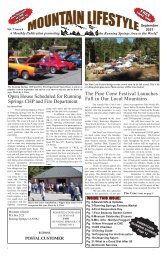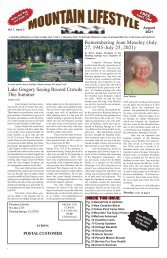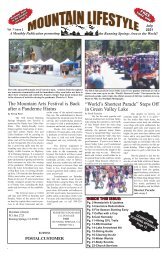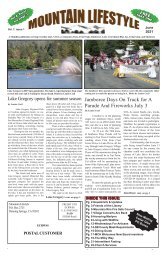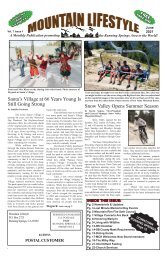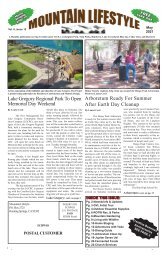June2020-Mountain Lifestyle-Running Springs edition
You also want an ePaper? Increase the reach of your titles
YUMPU automatically turns print PDFs into web optimized ePapers that Google loves.
The perennial pea vine adds pink to
the roadside mix on Hwy. 18. Photo
by S. Peter
Indian paintbrush. Photo by S. Peter
Lupine nicknamed “Soda Pop Lupine” grows abundantly here also roadsides,
meadows as seen from Hwy. 18 here. Photo by S. Peter
The Mountains Receive Some
Added Color
Steven Peter
Because of a late season that
was heavier than the usual rain in
April, the San Bernardino Mountains
are just now adding lots of
color to roadways and hiking trails.
With the usual shades of mountain
green, flowers from red to purple to
yellow share the roads and trails to
give the hiker or driver scenery they
are unlikely to see along their open
roads and trails in the valley below.
The scenery has been brought
to you from those wonderful early
April rains. And with the opening
of the county to tourists since the
stay at-home-orders, they can also
enjoy what we see on a daily basis
here.
One that we see prevalent
along Hwy. 18 is Grape Soda Lupine.
Grape soda lupine gets its
name from its sweet grape-like
flower fragrance. It is a small shrubby
perennial growing to 2-3 ft. tall
and spreads 4 ft. wide with silvery
foliage and tall spikes of purple-blue
flowers. It is found along
roads and pathways and seem to
spring out from among rocks along
mountain highways. It is adapted
to full sun, well drained soils and
grows very quickly in the San Bernardino
Mountains.
The legume seeds of lupins,
commonly called lupin beans, were
popular with the Romans, who cultivated
the plants throughout the
Roman Empire. Seeds of various
species of lupins have been used as
a food for over 3000 years around
the Mediterranean and for as long as
6000 years in the Andean highland.
Lupins were also used by many Native
American peoples such as the
Yavapai in North America. Eurasian
and North African lupins or
lupin bean are high in protein, dietary
fiber, and antioxidants, very
low in starch, and like all legumes,
are gluten-free. Lupins can be used
to make a variety of foods both
sweet and savory, including everyday
meals, traditional fermented
foods, baked foods, and sauces.
The perennial pea vine, perennial
pea, or everlasting pea is a
robust, sprawling perennial in the
Pea family. It’s native to Europe but
is present on other continents, such
as North America and especially in
the Southern California Mountains,
where it is most often seen along
roadsides.
This perennial pea can reproduce
quickly from its taproot and
rhizomes, or by reseeding. The vine
(climber), can reach 6 feet or more
by means of twining tendrils, but in
open areas sprawls. It is frost-hardy,
long-lived, and slowly spreading.
Bumblebees pollinate the flowers.
Butterflies visit the flowers for their
Added Color: cont. on pg. 5
Trails of the San Bernardino’s
National Children’s Forest
by Lynette Eastwood
One of the most popular hikes
in the San Bernardino Mountains is
the hike through the National Children’s
Forest. The total size of the
forest is 3400 acres which includes
forests, meadows and some rather
large boulders. It has some of the
most beautiful scenery in the San
Bernardino Mountains, being near
the top of some smaller mountains
opening unto a bluff with very few
trees. The area was created in 1970,
after a fire known as the Bear Fire,
due to the replanting of trees bearing
the names of children. There is a
.75 mile Interpretive Trail at the top
of Keller Peak next to the forest and
is still very popular todaEsIn 1993,
By Lynette Eastwood
This fire lookout built in the San
Bernardino National Forest, is the
oldest remaining tower. Built in
1926, it is designated it is historic
landmark.
The views from this landmark are
spectacular. You can see the San
Gorgonio wilderness, the Santa Ana
River drainage and the back side of
the Seven Oaks dam.
The lookout, road and peak are
named for Ally Carlin Keller, born
in San Bernardino in 1868. He at one
time was an employee of the Forest
Service, and his father was an early pioneer
in the area.
Besides the gorgeous view you can
view two memorial plaques at Keller
Peak’s lookout. First one designates
the first trail was established by a
group of children from around the
country. In addition, there is a Visitor
Information Center, an Environmental
Education Program, a Youth
Leadership Volunteer Program, and
an active reforestation program.
All this to teach children how to be
stewards of the land through education
and opportunities. Additionally,
there are maps (both hiking and
biking), camping information, and
general info on the history of the
area. The center is adjacent to the
Deerlick Fire Station on Hwy. 18
in Running Springs, approximately
1 mile east of Highway 330. The
phone to the Visitor Information
Center is (909) 867-5996.
Exploring Kellers Peak Lookout
the 1926-built tower as a historic landmark.
The second 200 yards to the west
marks the spot where a B-26 bomber
crashed December 30, 1941. Some of
the wreckage is still visible. This lookout
is open to visitors from 9:00am to
5:00pm each day beginning on Memorial
Day through November, depending
upon road conditions.
You can take Highways 18 or 330
to Running Springs. Go past the village
immediately after Deerlick Fire
Station. Turn right on Keller Road
(1N96). This 5-mile road is paved all
the way to the lookout. At a fork in the
road, turn right and drive to the lookout.
The lookout is manned by volunteers
who look for any forest fires which
might erupt. Besides taking gorgeous
pictures you can climb up to the top
of the tower. Usually a volunteer will
be there to greet you and answer your
questions.
nectar, but do not pollinate. The
plant attracts the caterpillars of the
Tiger Moth and some smaller animals
may feed on the leaves. However,
the seeds are poisonous.
Mention the word “wallflower”
and most people conjure an
image of a shy, unassuming person,
literally pasted to the wall in stressful
social situations. In botanical
circles, though, wallflower is the
common name for a genus of mustards
(Brassicaceae family). The
Wallflowers are found in small
patchs through the mountain area.
Photo by S. Peter
flower earned the name wallflower
for its habit of growing on stone
and masonry fences and walls.
Practitioners of European folk medicine
have used wallflower poultices
to relieve bronchial congestion
and American Indians used dried
leaves or seeds of Plains wallflower
to make a tea for stomach cramps.
Wallflowers are also important
sources of food for wildlife, including
the caterpillars of a number of
butterfly and moth species. Most in
the mountains are yellow to orange,
but species of blue, purple, red and
white have grown throughout the
western states of the US.
Castilleja, commonly
known as Indian paintbrush or prairie-fire,
is a genus of about 200 species
of annual and perennial herbaceous
plants native to the west of
the Americas from Alaska south to
the Andes and northern Asia. The
generic name honors Spanish botanist
Domingo Castilleja. The flowers
of Indian paintbrush are edible
and were consumed in moderation
by various Native American tribes
as a condiment with other fresh
greens. These plants tend to absorb
and concentrate selenium in their
tissues from the soils in which they
grow and can be potentially very
toxic if the roots or green parts of
the plant are consumed. Highly alkaline
soils increase the selenium
levels in the plants. Indian paintbrush
has similar health benefits to
consuming garlic if only the flowers
are eaten in small amounts and in
moderation.
Please continue to ...
Shop Local
Why Shop Local?
• Locally owned companies return revenue back into our local
economy.
• Local business owners live in the community and are invested
in its welfare and future.
• Local businesses often sell locally-made products which promotes
community identity and creates more local jobs.
• Shopping locally is one of the best ways to show pride in the
place you live and helps support the businesses that make
our town unique.
San Bernardino County Is now entering...
Phase 2: Retail, Malls and Dine-In Restaurants can now open
with COVID complient safety measures.
Our local businesses are taking extra precautions to
keep our community safe.
Please continue to support them whenever possible
during this uncertain time.
Page 4 Mountain Lifestyle June 2020
June 2020 Mountain Lifestyle Page 5







